I can be so greedy. If I have 11 days in Alaska, I will cram those days so full of “Alaska” that by the end I’ll be choking on snow. It’s a frenzy that actual Alaskans understand but typically reserve for the height of summer — “Do all the things, we can rest when we’re dead winter’s here.”
Beat and I had two down days in Fairbanks between our first wilderness trip — 80 arduous sled-dragging miles over five days — and our second, which would demand nearly 85 hillier and colder miles over four days. One of those down days was Christmas Day, when even Beat unapologetically put his feet up in front of a cozy fire. I had agreed to a couple of work shifts (sure, give me 9 days off, I’ll work Christmas) and had about two hours to spare as I wheeled Corrine’s fat bike out of the heated garage into a weirdly warm morning (it was 23 degrees, basically summer.)
“You never take rest days,” Beat chided me.
I rattled off numerous excuses and justifications for a Christmas Day activity. I showed Beat my watch which registered my status as “recovered” even though I had hiked for eight-plus arduous hours each day for the previous five days (I only wear my watch occasionally and train so randomly that its metrics are effectively useless.)
“You’ll regret it.”
Despite Beat’s admittedly sound warning, I rode Corrine’s bike on snow-packed trails for two hours. It was glorious. Still, it was my first time on a fat bike this season, I forgot how much extra wattage and glute strength the exercise demands compared to indoor cycling. Also, my legs were tired.
But then I did it again the next day, this time for nearly three hours, which made me late for work.
“I’m not going to wait for you when you’re slow tomorrow,” Beat teased.
“It’s going to be too cold for waiting and I’d be slow either way,” I countered.
The temperature was a few degrees below zero when we set out from the McKay Creek trailhead on Dec. 27. Beat and I strapped on our sleds, which likely weighed more than 60 pounds each with four days of food and fuel. The trail immediately launched skyward, gaining over 1,000 feet in the first two miles with brutal grinds up 15% grades. My glutes protested and I tugged at them as though I was coaxing the fifth rep of a maxed-out deadlift. My watch registered speeds of 1.6 to 1.9 mph. I put my head down and groaned because this was all I had.
“Namby-pamby posterior chain,” I grumbled at my hamstrings and calves that were giving me nothing. Then I wheezed out a little laugh because, really, “namby-pamby?” Am I my Grandma Homer? She would have told me to get my butt in gear and “Homer Up.”
But my butt only had one gear. Namby-pamby.
At least it was a beautiful day: Wispy sunlight and sparkling rime coated everything as the trail climbed above the fog. At mile five, I topped out on a rolling climb above 2,500 feet, which I always like to remind myself is lower than any point in Colorado but feels like the edge of the moon in Interior Alaska. At least I can breathe up here.
The scenery was breathtaking though — a frosty island of snow above the inversion, bathed in the golden light of sunrise … or was it the sunset by now … or does it even matter? Fog blanketed the Chatanika River Valley like a tranquil sea.
As I glided trudged through the delicate world, I ruminated on Mark Manson’s book, specifically his references to becoming “antifragile.” A few weeks earlier, Beat was laughing because a co-worker used this phrase, which he argued was a pretentious and “made-up word that means ‘robust.’” I told him that his colleague didn’t invent the phrase. I’d seen it in a few of the weightlifting Substacks I’d browsed in recent weeks. According to Mark, antifragility is a property of things that not only gain from chaos but need it to survive and flourish. Antifragile doesn’t just withstand a shock — it improves because of it.
“The more antifragile we become, the more graceful our emotional responses are, the more control we exercise over ourselves, and the more principled our values. Antifragility is therefore synonymous with growth and maturity,” Mark wrote.
This was one of my “ah-ha” moments from the book. If I have any resolutions for 2025 (besides learning French, which has been on the list since 2022 to no avail) it’s to strive to be more resilient. And by resilient, I don’t mean “tough” or “robust.” I mean ready to face the chaos and to withstand it. The 2020s have given me a harsh new perspective on uncertainty and loss, and with it the realization that “you ain’t seen nothing yet.” If the fire comes to take everything away, I want to find the strength to stand tall in the ashes and appreciate what’s left.
It is funny to ruminate on antifragility when my circumstances have left me feeling weak and vulnerable. One might think that we come to the Alaska wilderness to prove our badassery to ourselves, that we take on difficult tasks in the merciless winter conditions to feel powerful. For me, the opposite is true. I’m a speck out here; a weak and hairless little mammal for whom a single slip in judgment could be catastrophic. Every creature out here from the moose to the black-capped chickadee is far more suited to survival. I am nothing, and Alaska doesn’t care. This is precisely the reason that I need this place.
The trail became softer beyond the Richardson cabin intersection. Still, my legs started to perk up a little. It probably helped that I was descending, although my sled still dragged along like a dead body and my watch hardly noticed a difference — 2.1, maybe 2.2 mph. My glutes inexplicably started to cramp on the steepest part of the descent.
Corrine and Eric passed on their bikes after the trail dropped back into the fog at Ophir Creek. They were perky and I gleaned a little energy from them. Eric asked me to pose for a photo while he removed his deeply buried phone and several layers of gloves. My glutes started to quiver unnervingly during this short bout of rest. I wondered how I’d cope if a muscle seized up entirely out here.
I reached Cache Mountain cabin after nine hours and 20 minutes of nearly nonstop trudging, and by then my stomach had turned. It was a chore to force down whatever freeze-dried meal I’d pulled from my pile for the night, and then I made the mistake of letting Beat pour Baileys into my hot chocolate. My gut was apoplectic. Everyone was tired and lights-out came early even compared to our previous trip, a mercy. But I was up several times during the night to run to the outhouse. The first time, I failed to put on my coat and mittens beforehand and had to contend with painful rigid fingers for the next half-hour of writhing in my sleeping bag. I didn’t make this mistake again.
I thought the day’s hard haul and night’s GI distress would to take me out of the running for the following days. But in the morning, I felt surprisingly good. Corrine and Eric headed home and Beat and I set out for a day trip toward the Cache Mountain Divide. I thought I could get away with more miles if I carried a backpack rather than drag a sled, but the pack was cumbersome and top-heavy. There isn’t a lot of survival gear I’m willing to leave behind.
Beat turned around after six miles to take on the much more arduous task of gathering firewood. I continued toward the pass. The day was quiet and gray, beautiful in its own way.
The pass was rime-coated and misty — almost rising above the fog, but not quite. I was blissfully content, but my legs again were registering their complaints. This time, it wasn’t my glutes, it was my calves.
Day three was the “Magic Light” day I wrote about previously. This was probably one of my favorite days ever in the Alaska wilderness, but another 22-mile trudge at temperatures down to 35 below exacted a harsh physical toll. That night, even my down parka and pants weren’t enough to make the trips to the outhouse bearable, and I genuinely wondered whether I’d find the strength to hike out the next day.
But I know from experience that our bodies find a way when we don’t have a choice.
In the morning, left the cabin about a half hour before Beat. I started the book “James,” and all I can say is wow. The hype surrounding that novel is deserved. The story starts slowly but soon I was enthralled. The audiobook reader deserves an Academy Award.
It did help to be largely distracted by prose. Beat passed me on the long climb after Beaver Creek, gliding effortlessly past as though I was standing still. My main goal on this day was to not make him wait too long at the trailhead, as it was sure to be a cold wait. Temperatures again dropped to 35 below. I searched for ways to trick myself into speeding up. I imagined deadlifting, the satisfaction of pulling up the bar with the big red weights, but I could not coax anything more from my addled glutes and angry calves.
Amid the hard work and likely calorie deficit from managing an upset GI tract, I had a difficult time regulating my temperature. I was pumping out excess heat or shivering with little in between.
I crested the hill above Ophir Creek and caught a hint — just the tiniest hint — of direct sunlight. It was like a shot of caffeine to my veins, an instant jolt of energy. My dead-body sled began to glide as the trail dipped down the hill. I lifted my weary feet into a run, an actual run, loping down the trail as though I were a black-capped chickadee about to take flight. Just as I crossed back into the shadows, I heard an odd clattering sound and stopped. When I looked back, my sled pole rested on the trail with nothing attached to it. I’d accidentally dropped my sled.
Wearily, I unhooked my harness, hoisted the pole, and trudged back up the hill. My sled rested in the middle of the trail exactly where I’d first felt that hit of sunlight and took off at a sprint. Of course I was able to run; I was no longer dragging the dead body. Apparently, the sled also had no desire to leave the warmth of the sun and chose this place to let go.
The sled’s attachment mechanism has two hooks with spring-loaded arms, which had broken on both sides. For this trip, I had made the unwise decision to leave the bulk of my repair kit at home, reasoning that I could rely on Beat. But he was at this point probably miles ahead. Luckily, I possessed four unused carabiners that I was able to link together to bypass the broken arms. It took a while to parse out the correct placement of the biners, and for long minutes, I worked the cold metal with my bare hands. I was grateful my sled chose this warm sunshiney spot to break down, rather than doing so in the shadows where it was still 25 below.
As the sun slipped away, my body began to break down. My glutes were cramping again, and now my Achilles tendons were flaring up painfully. What were all of those calf raises at the gym even for? Well, I supposed that if you do zero specific training, you can’t expect miracles when hauling heavy loads over 160 miles in nine days.
Worth it though? Yes, worth it. I settled into my discomfort, thinking, “An antifragile person would find a way to relish all of this.” Temperatures warmed as I climbed higher on the ridge. The “hot flashes” returned, but I didn’t want to waste more time stripping off layers. Even though I’d sent Beat a satellite message about my mishap, I was loathe to let another minute slip away. So I marched and watched ptarmigan scurry over the snow, flying awkwardly and perching their broad bodies on comically thin willow branches.
From the top of the ridge, I gazed south toward The Great One, Denali, backlit by a hazy sunset (this one was definitely sunset.) There’s a timelessness out here that puts me far away from my human fragility — and dreams of antifragility — into a space where I can simply be. The rhythm takes over and I can move without thought or pain, at least for a little while. I had paused “James” an hour earlier to let my attention span rest. Long-dormant memories of songs my teenage self cherished found their way in. “Fripp” by Catherine Wheel.
Bye bye long day
I need to sleep so much
You shine on me
Too much is not enough.

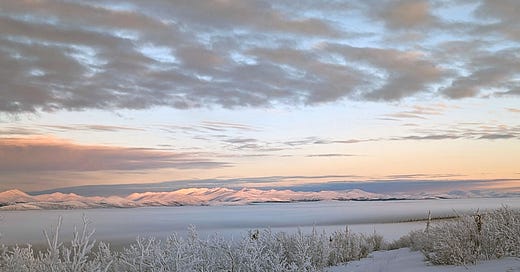



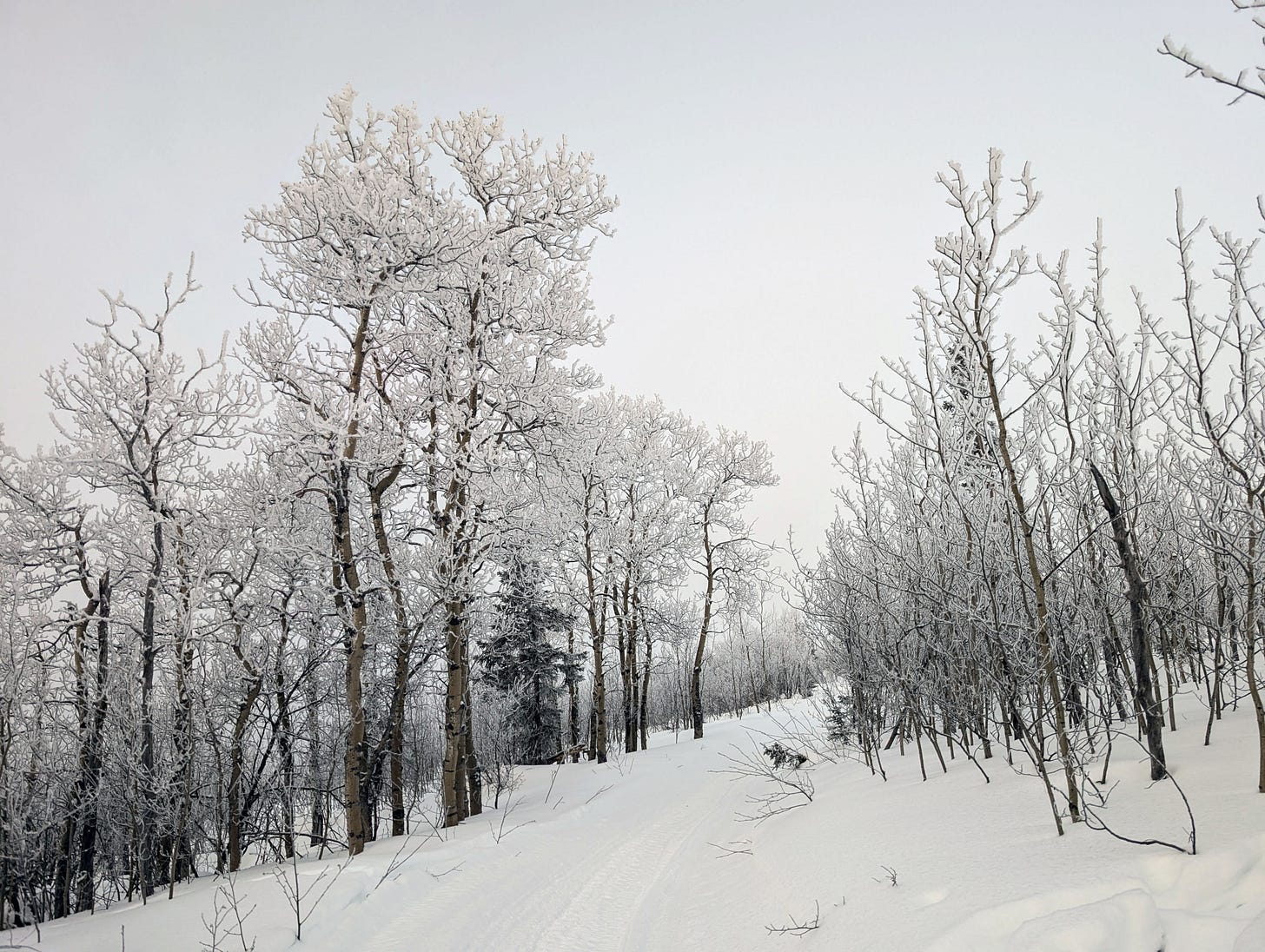

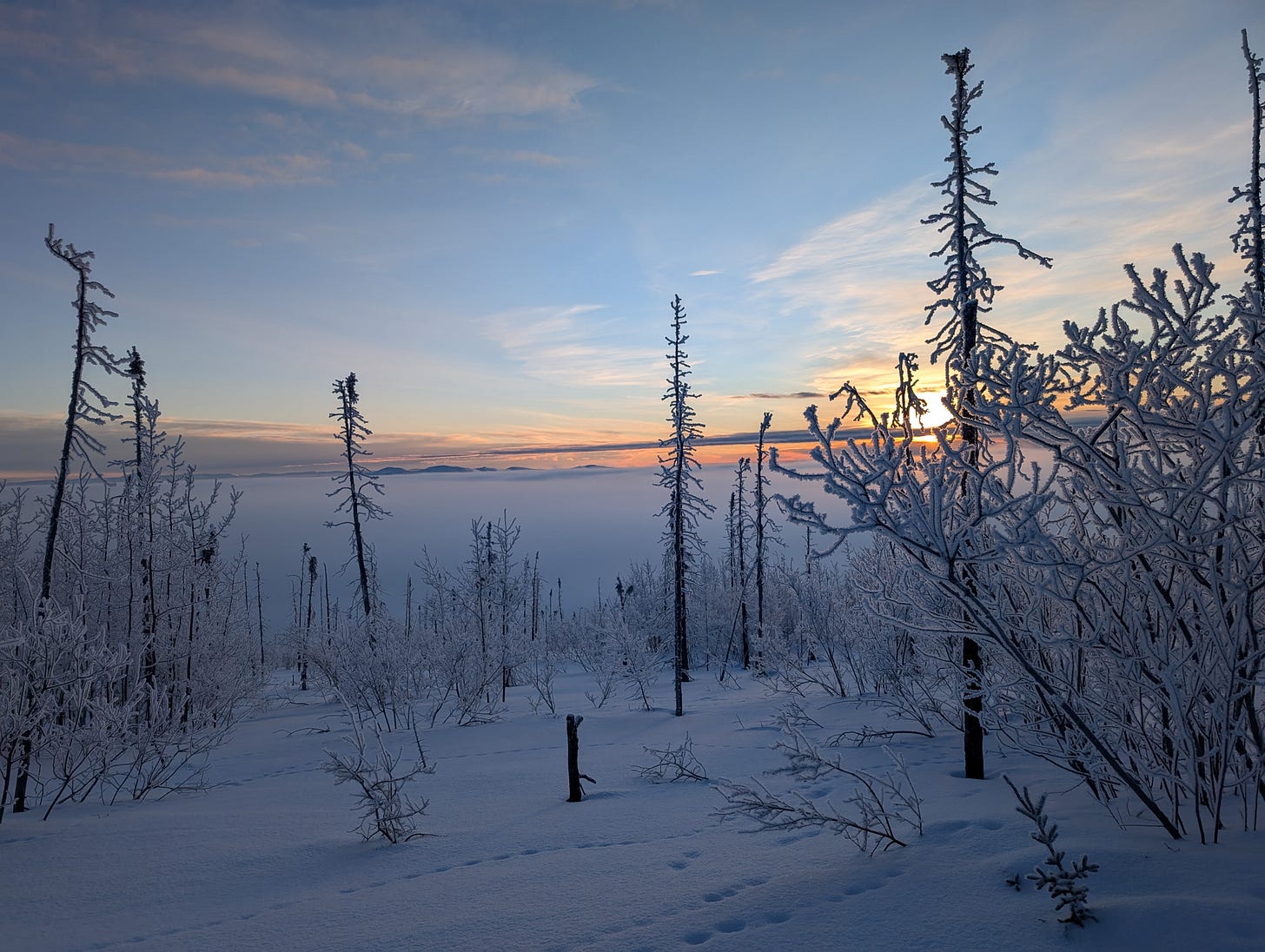
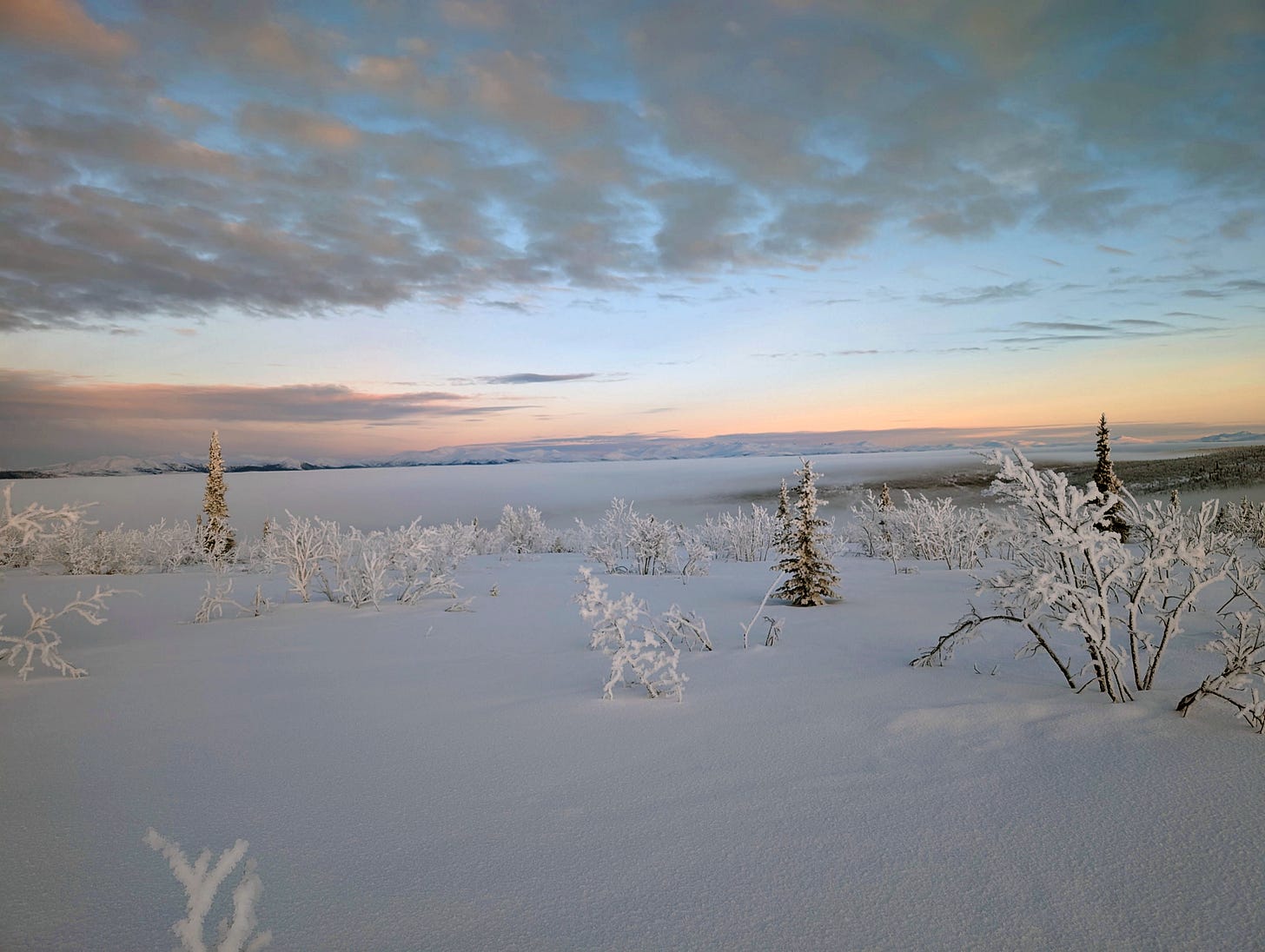
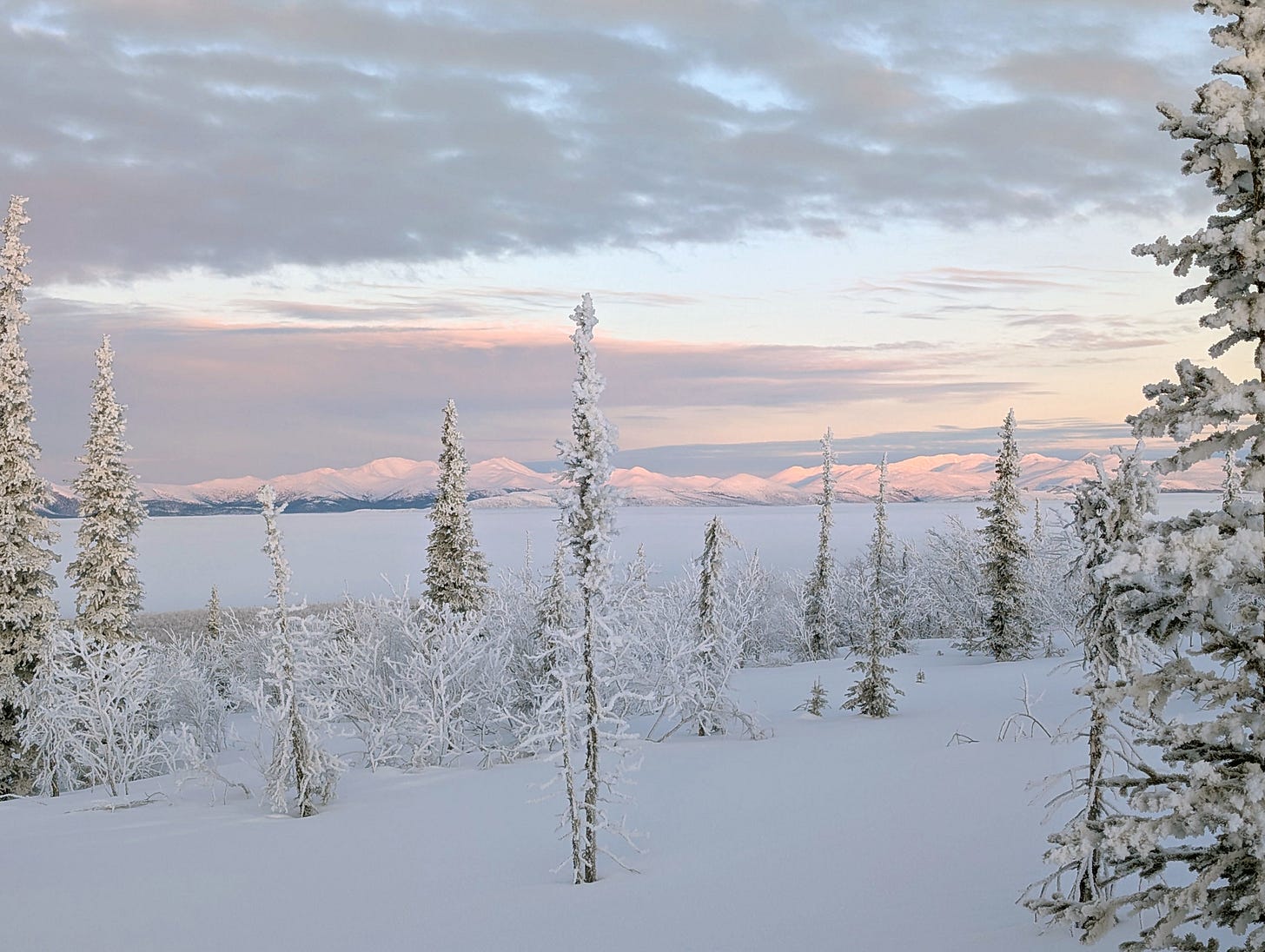
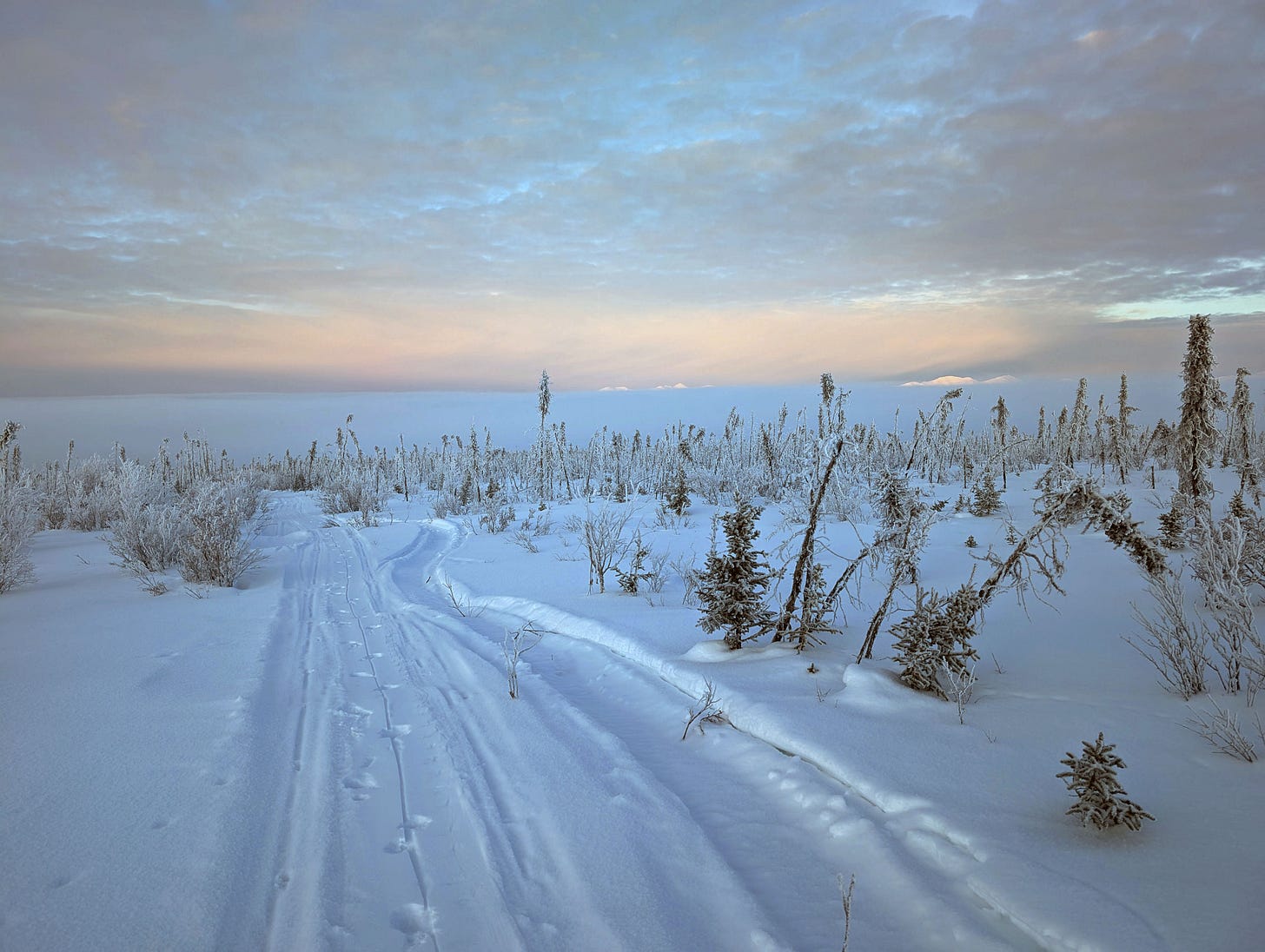
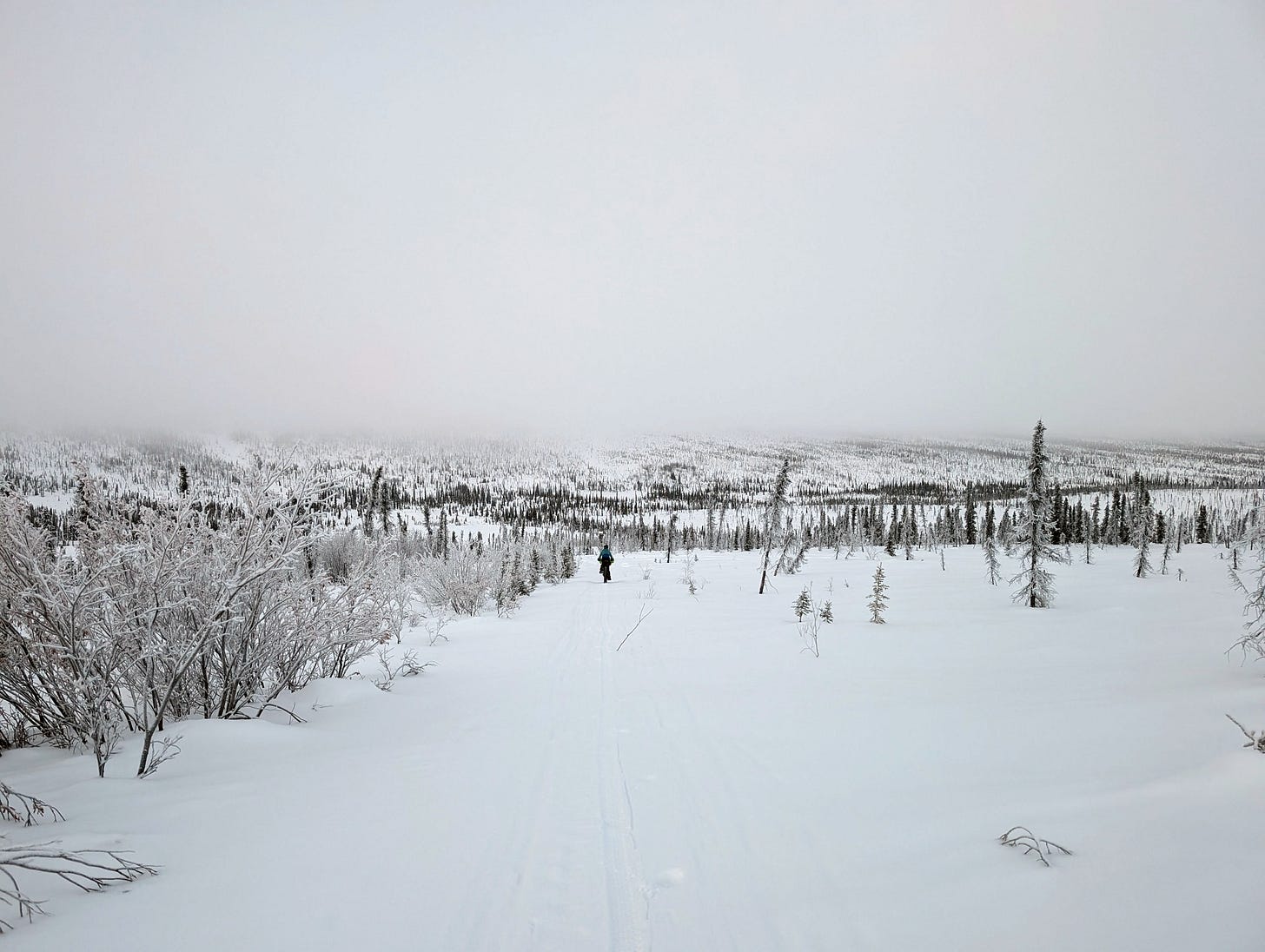
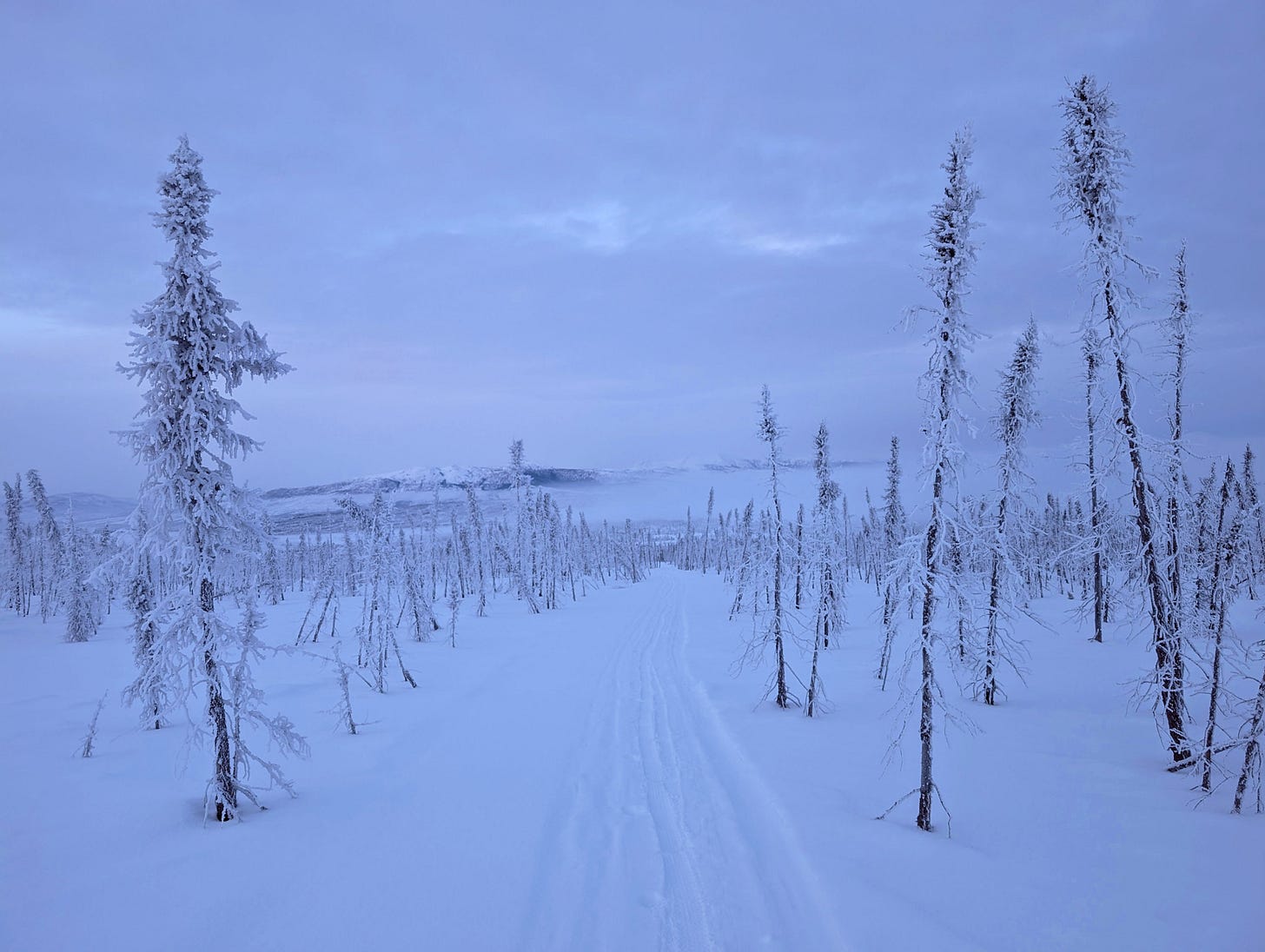
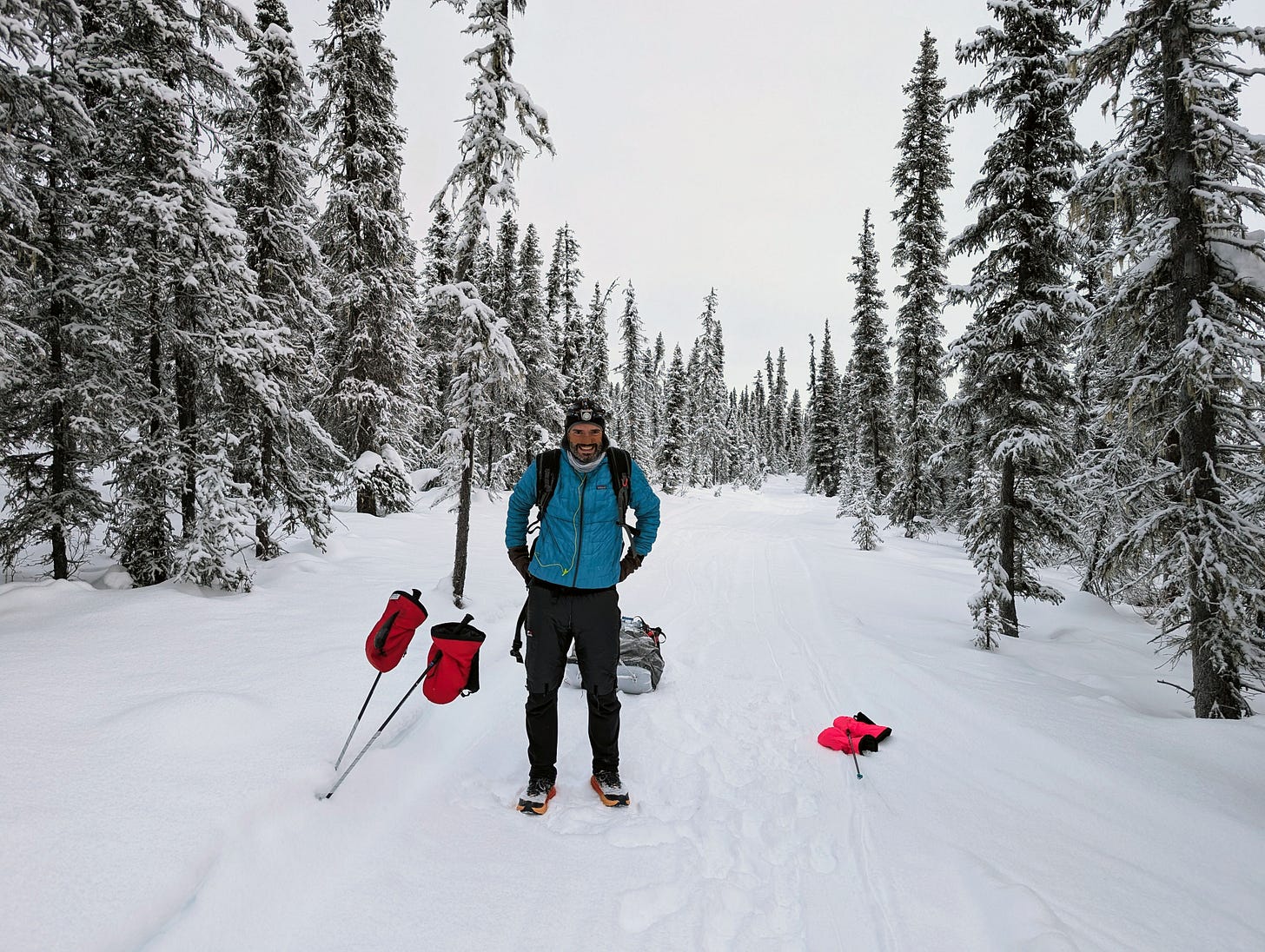
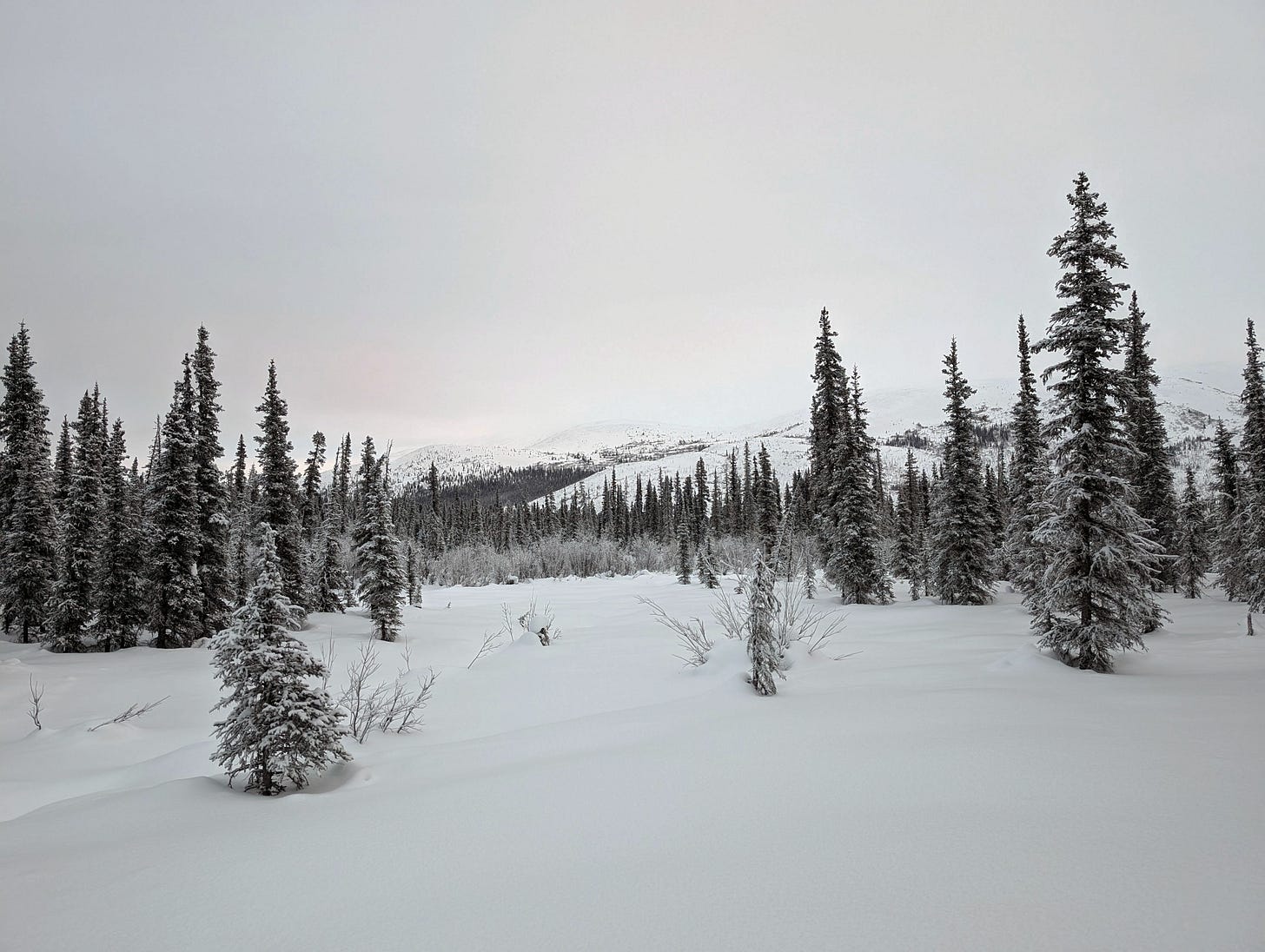
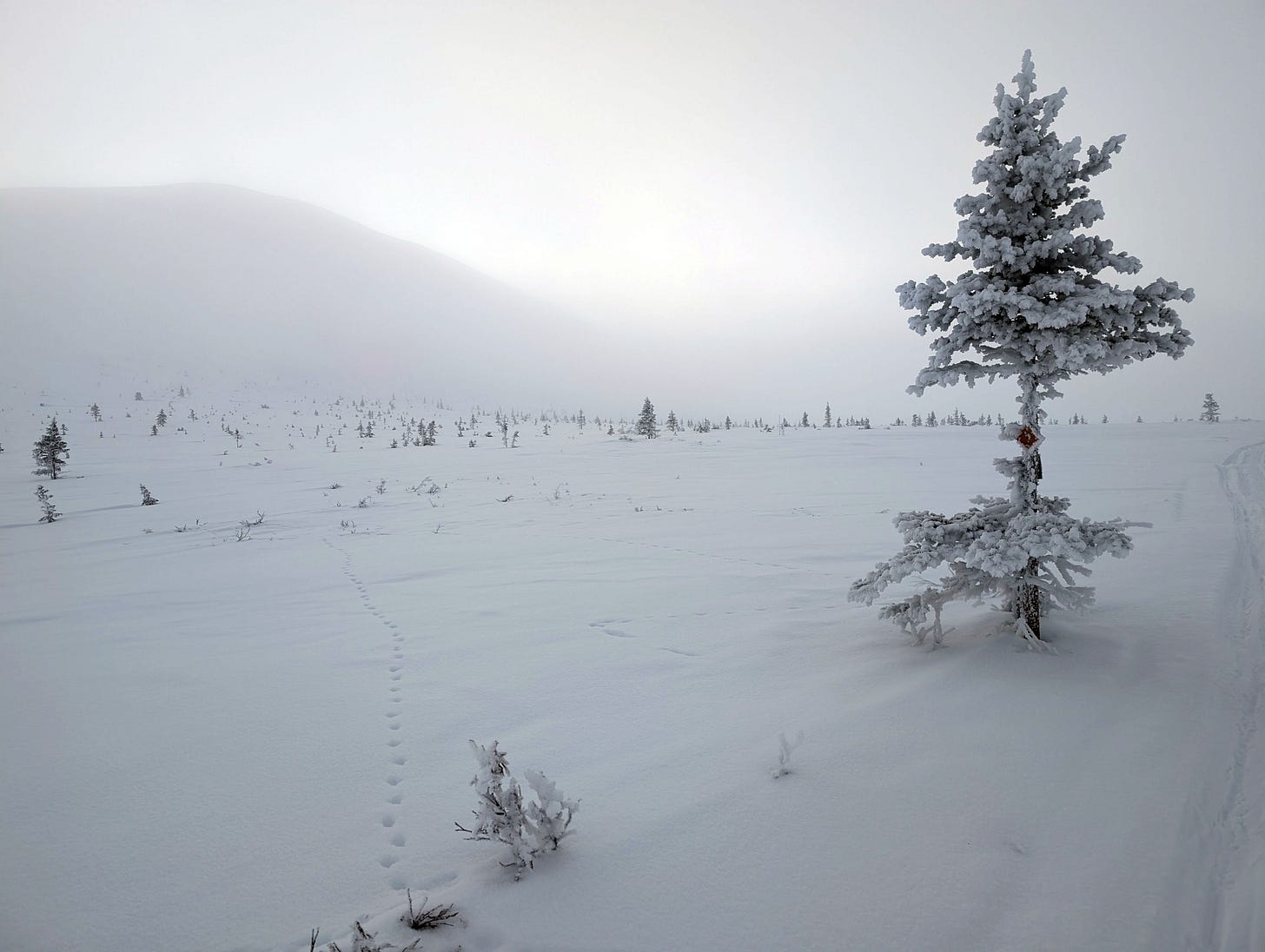
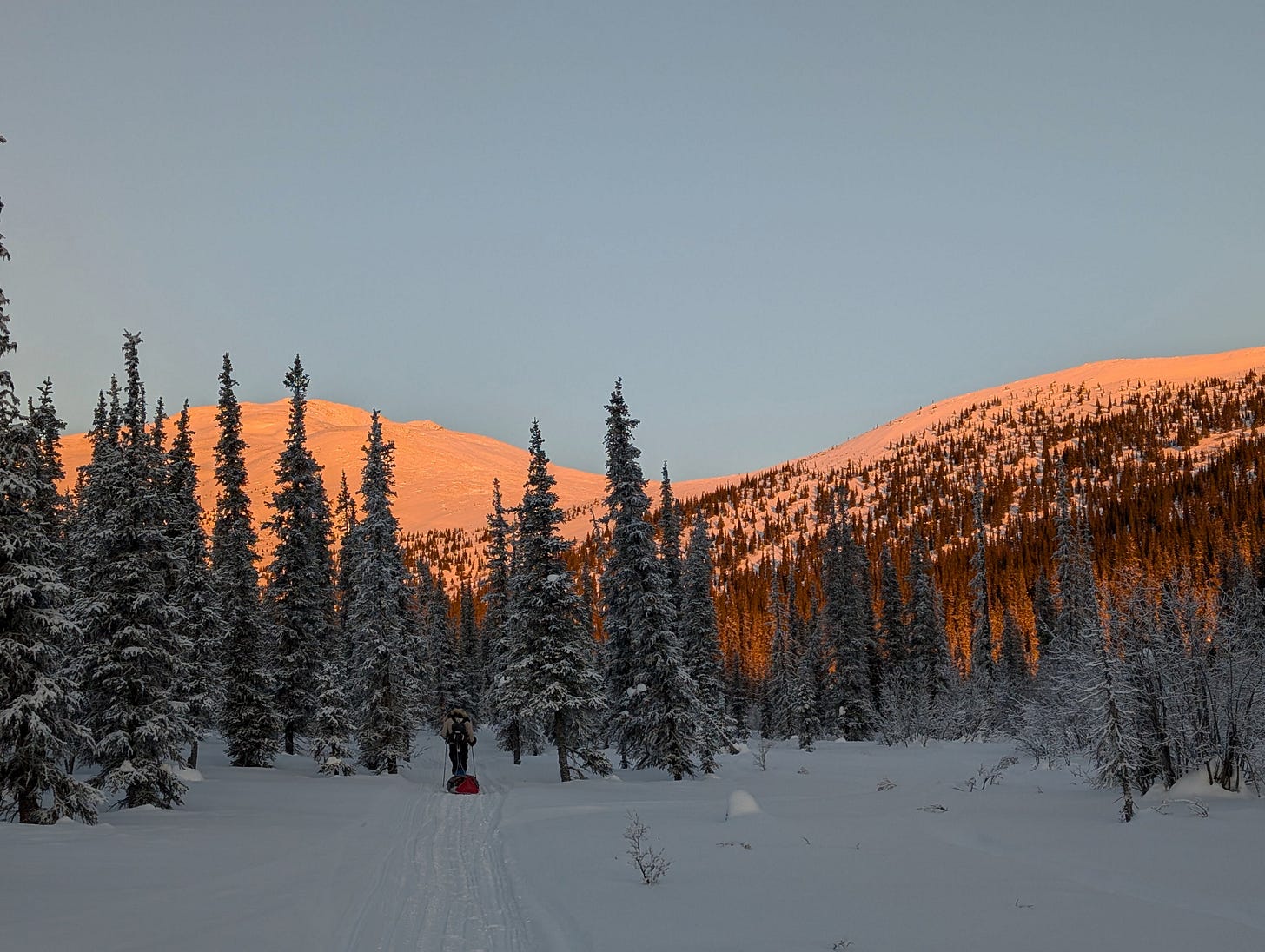
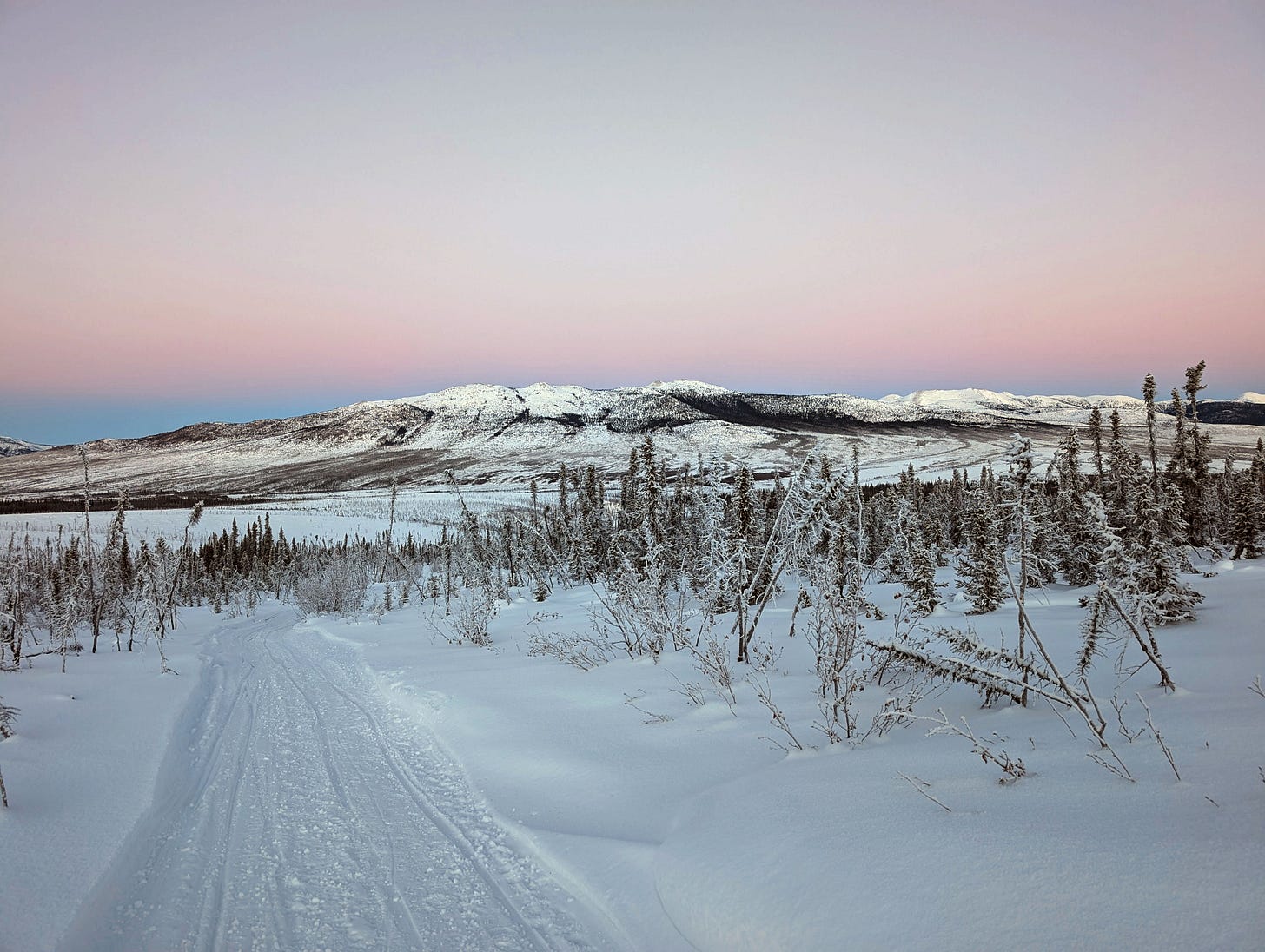
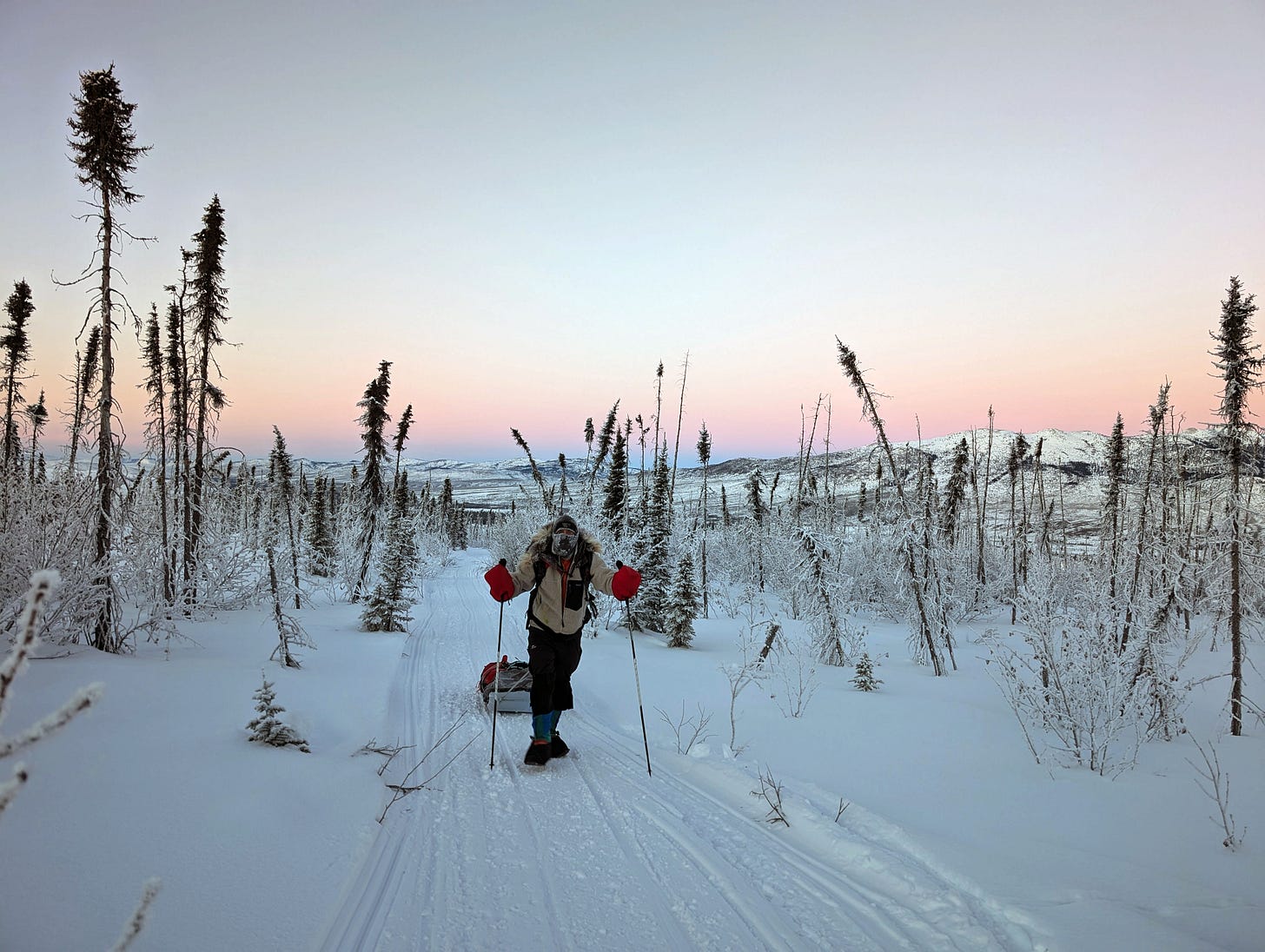
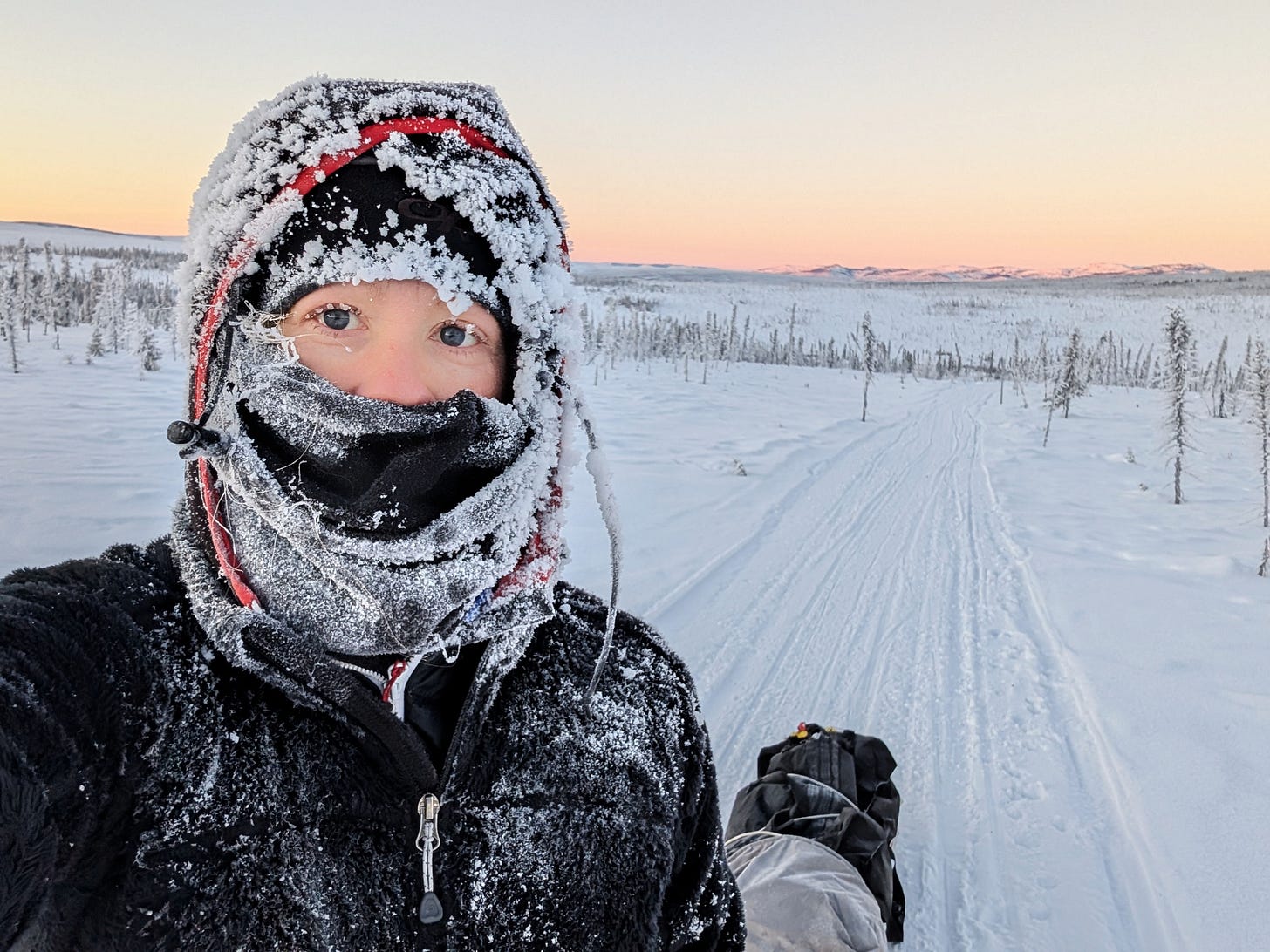
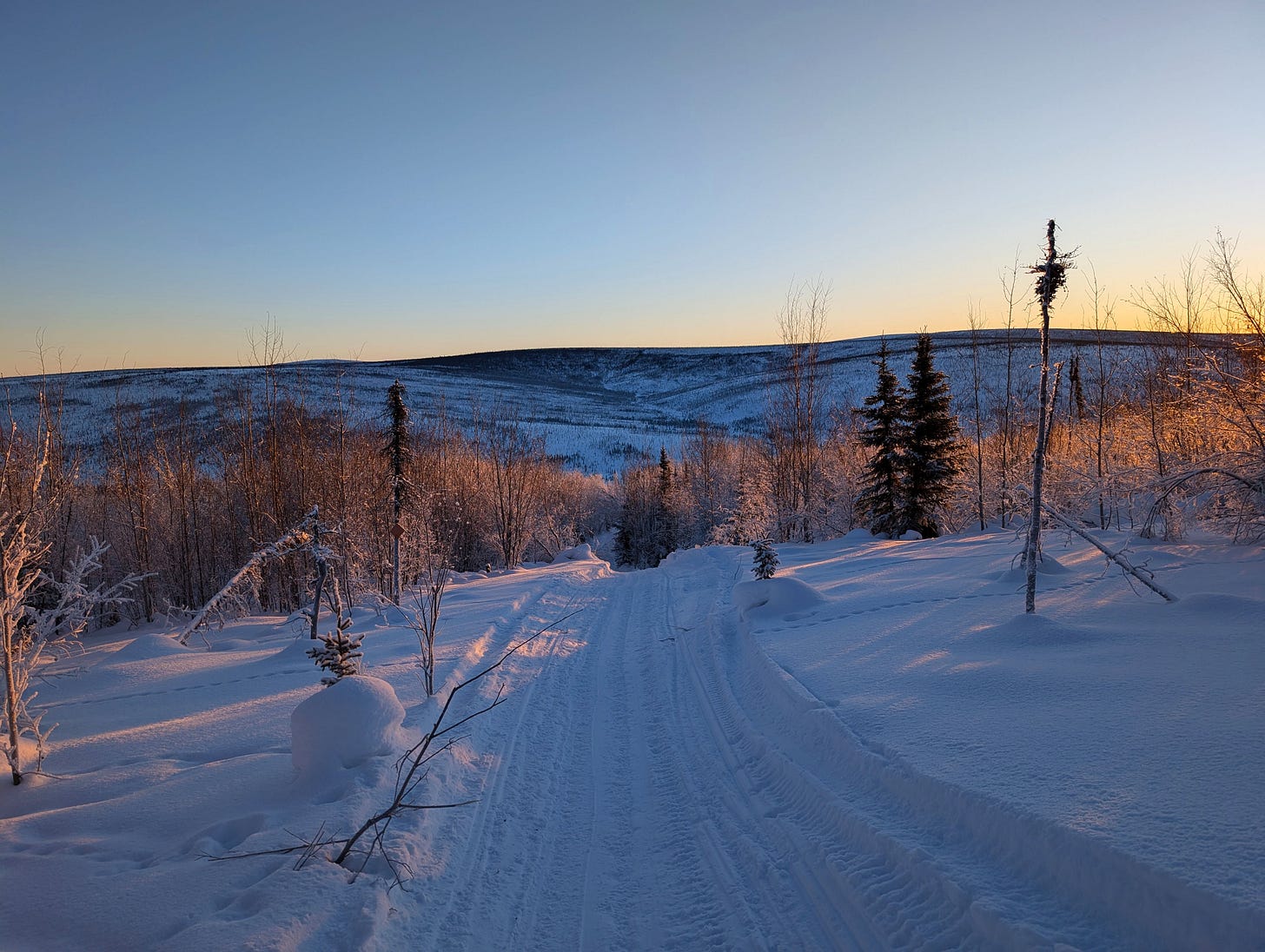
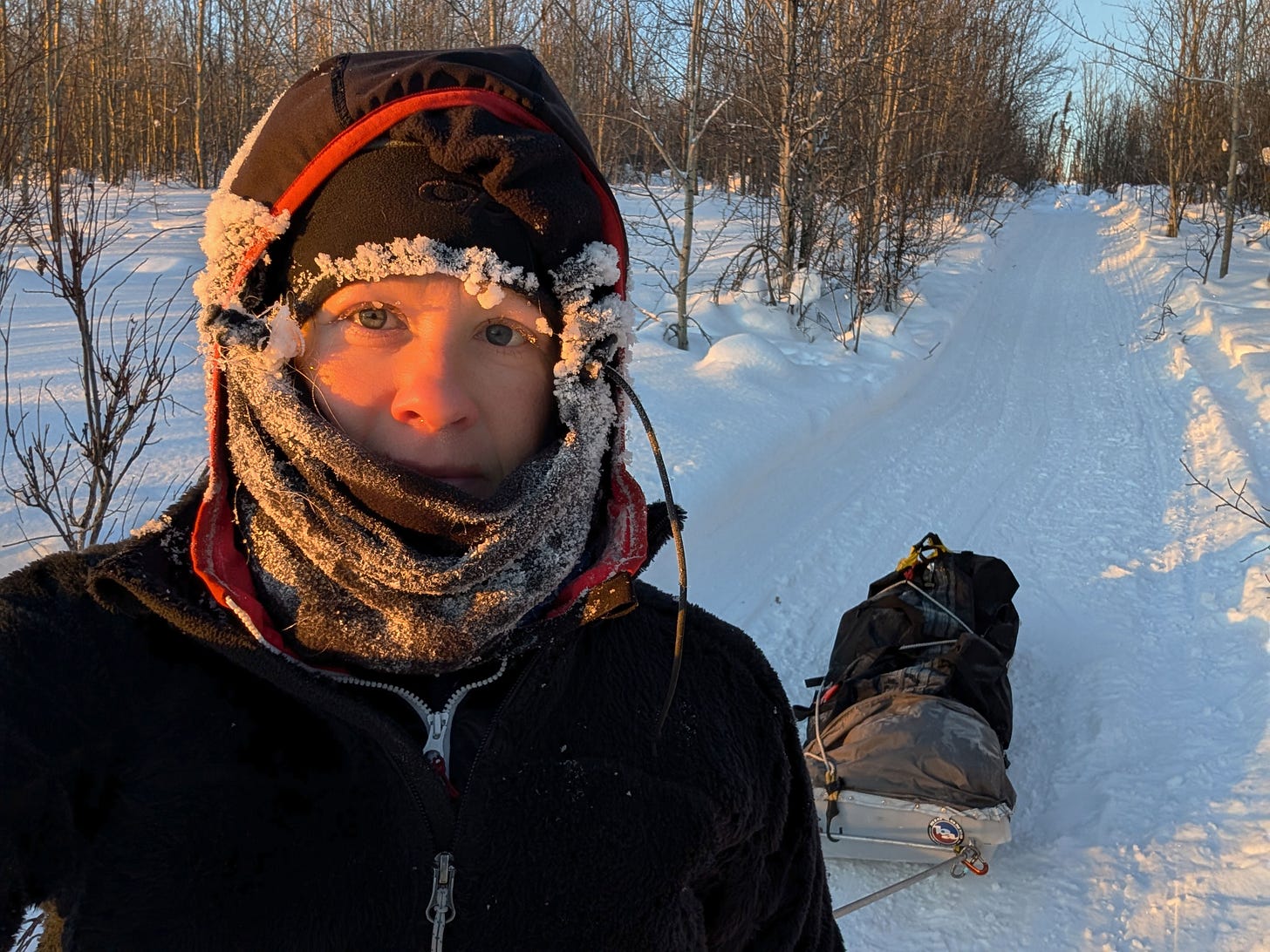
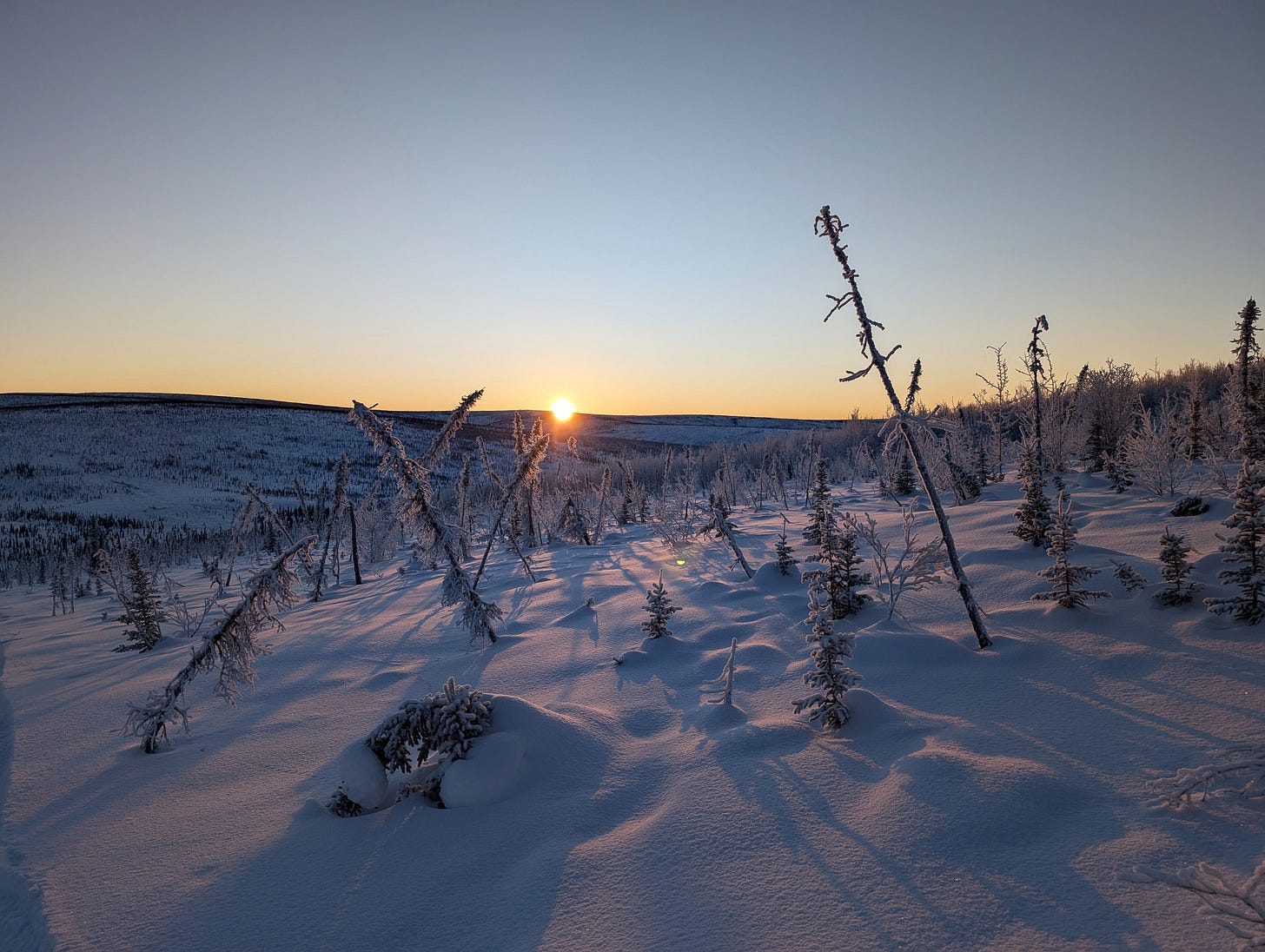
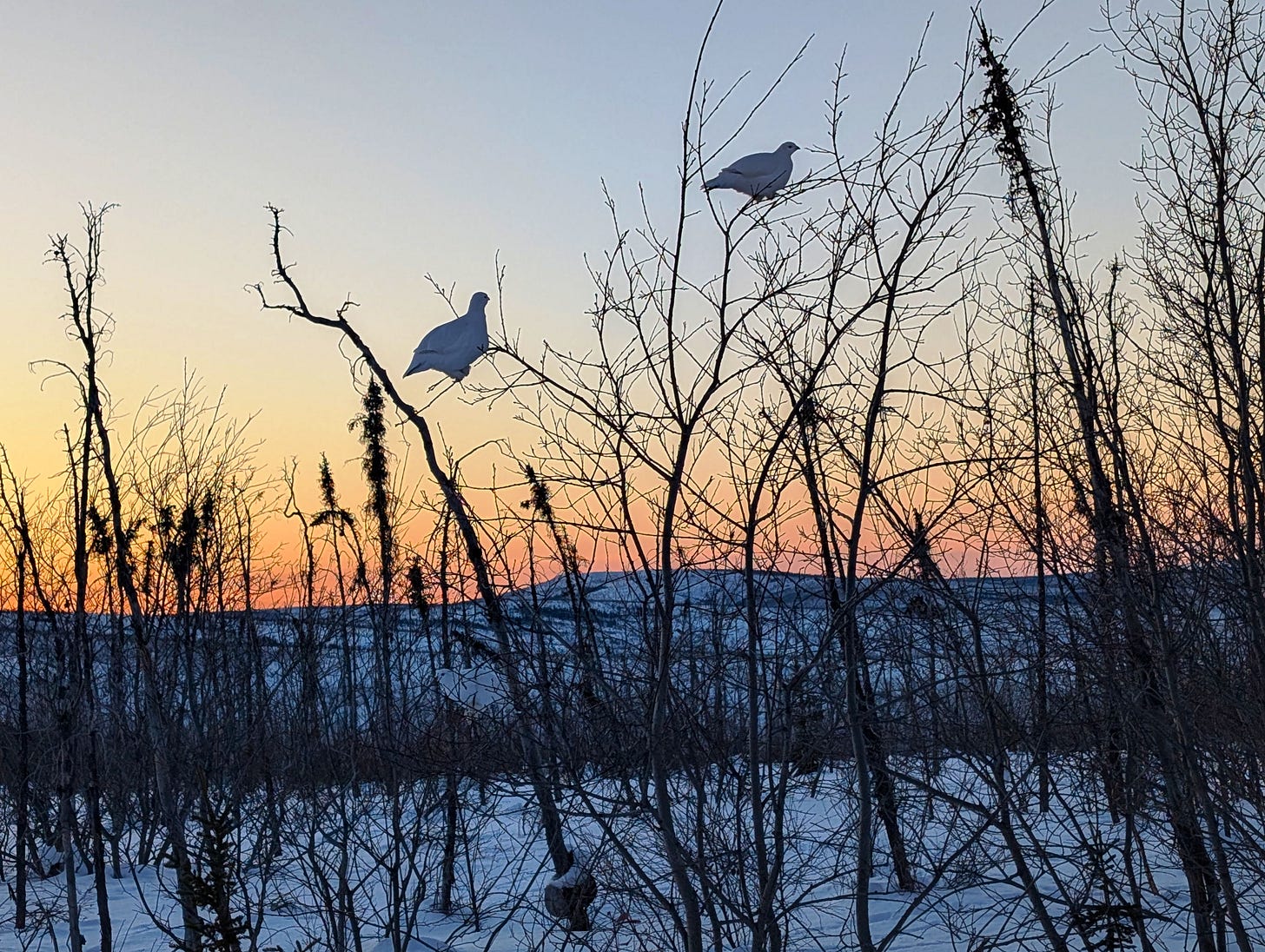
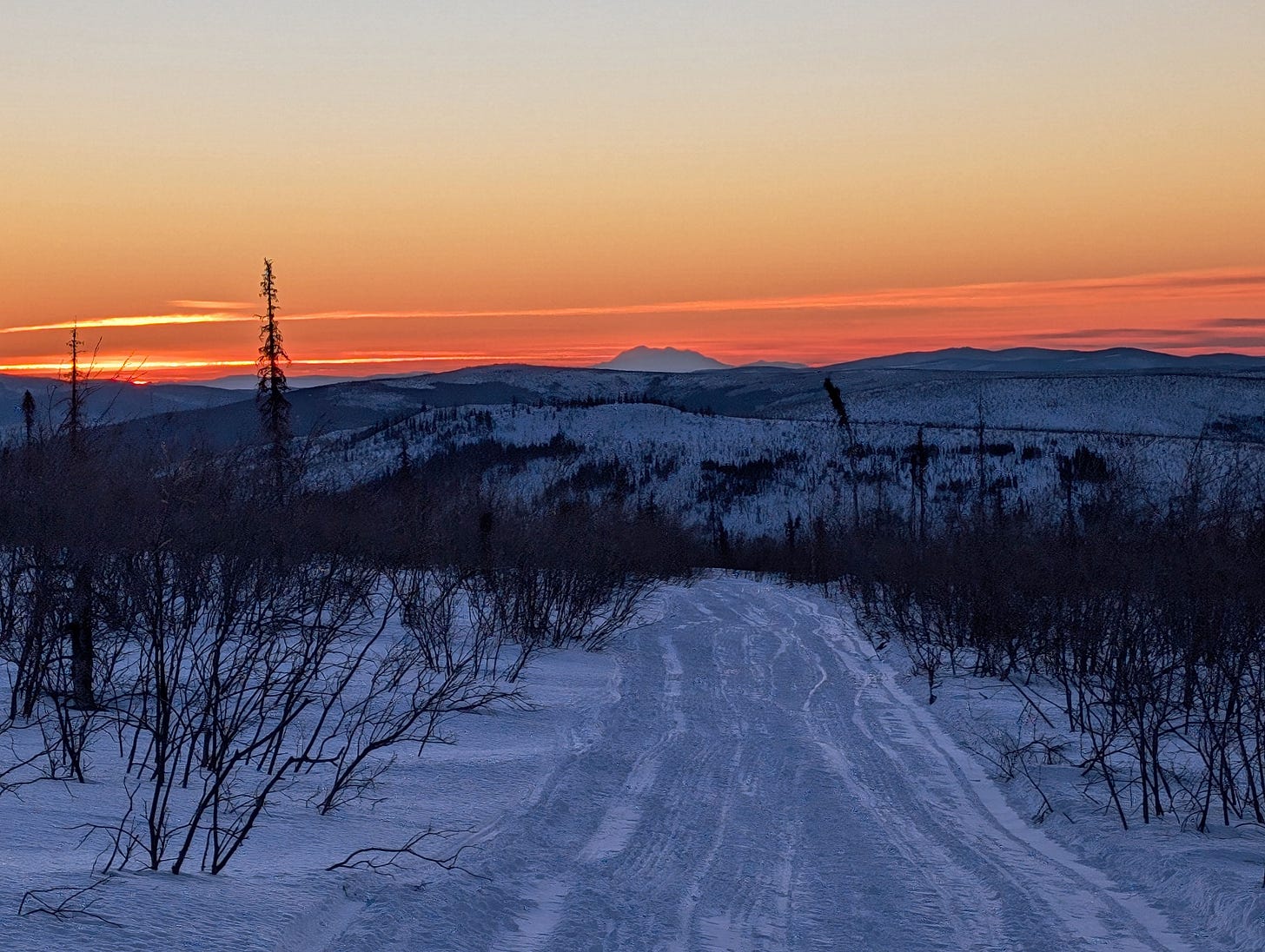
We'll just call you Aunty Fragile!
I love the Catherine Wheel. Wish they were still making music.